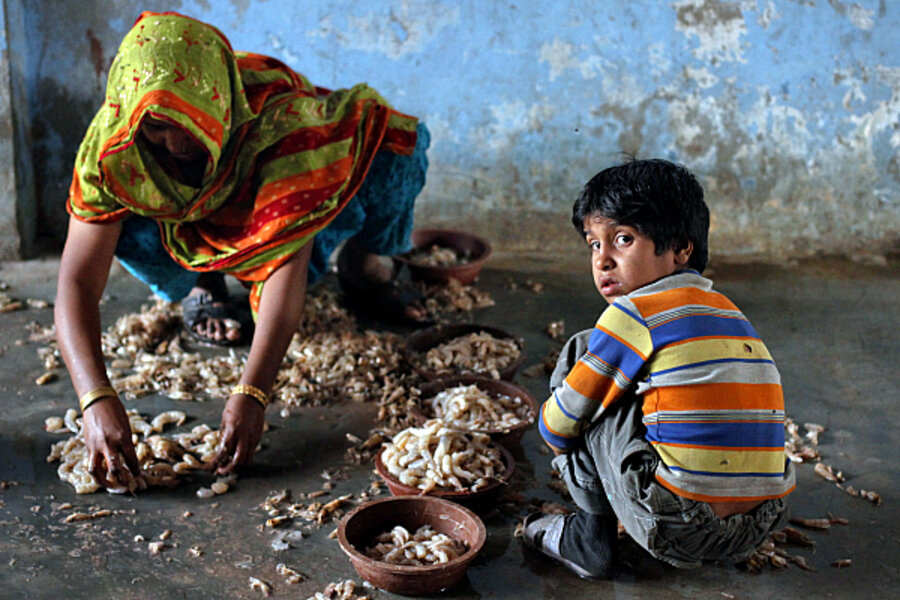What women really want for Valentine's Day: more freedom
Loading...
Valentine’s Day has long celebrated love with caring notes, decadent chocolates, and romantic arrangements of flowers. But this Valentine’s Day, perhaps it’s time to celebrate with a gift many of the world’s women desperately want and need: reproductive health.
According to the United Nations Population Fund (UNFPA), 1,000 women die every day due to pregnancy or childbirth, or one woman every 90 seconds. Ninety-nine percent of these deaths occur in the developing world, 90 percent in Africa and Asia. A handful of complications account for 80 percent of these maternal deaths – severe bleeding, infections, high blood pressure, obstructed labor, and unsafe abortion – and the bulk of these deaths are preventable.
Reproductive health, including access to the information and means to plan a family, is a human right the world’s nations have recognized in various forms since 1968. Access to family planning and other reproductive health services safeguard the lives of women and their children and promote families that are emotionally and economically healthy.
In my book, "More: Population, Nature, and What Women Want," I explore centuries of reproductive history and concludes that, if given the chance to do what they really want, women on average have smaller families, with childbirths later in their lives. This pattern is safer for women and children, and promotes environmental sustainability through the slower population growth that lower fertility rates and later births bring about.
The health of women and children
The UNFPA report "Women and Girls in a World of 7 Billion" notes that poverty, marginalization, and gender inequalities based on culture are key challenges to reproductive health. The report relays that women own less than 15 percent of the land worldwide; their wages, on average, are 17 percent lower than men’s; and they make up two-thirds of the world’s 776 million illiterate adults.
This means that women, particularly in the developing world, must often rely on men for financial support – creating situations in which women are subject to their partners’ views on contraception, feel trapped in physically or emotionally abusive relationships, and marry and have children young instead of pursuing further education or employment outside the home. In the developing world, one in seven girls will be married before she turns 15, and worldwide, complications from pregnancy and childbirth are the leading causes of death for girls 15–19.
Many women are not empowered to make their own decisions regarding if or when to have children, how many to have, and how long to wait in between them. Some 40 percent or more of pregnancies are unplanned, with more than 21 percent of all births resulting from such pregnancies worldwide, according to estimates of the Guttmacher Institute. If given access to family planning, and permission by their families and societies to use it, fewer women and children would die from unsafe abortions and high-risk pregnancies.
The health of the planet
The United Nations Foundation sponsors Girl Up, an organization that encourages a world where young girls can avoid the pitfalls of too-early marriage and childbearing and can instead go to school, enjoy health and safety, and grow into the next generation of leaders. In the Amhara region of Ethiopia, where half of adolescent girls are married, Girl Up is helping to promote education for young girls. The project offers basic literacy classes, family planning information, and agricultural training.
When women and girls are empowered with education and the capacity to make choices about sex, marriage, and childbearing, they have opportunities to realize futures as farmers, businesswomen, politicians, or whatever dream drives them. These benefits ripple out from the lives of individual women and girls to their families, their communities, their nations – and ultimately to the entire world.
In the Worldwatch report "Population, Climate Change, and Women’s Lives," I suggest that if women are given access to increased reproductive health, they are better able to more naturally control the size of their families and counterbalance the resource depletion and pollution that are exacerbated by unabated population increases. The importance of women and the autonomy they exercise may be far greater to the climate’s future than most experts and negotiators on climate change have realized.
What women really want
Reproductive health is not about state-mandated family sizes; it is about freeing women to make their own choices about when and how often to give birth. In all countries where affordable access is offered to family planning resources and women have the option of safe and legal abortions, women’s fertility rates drop to two or less children per woman. Such rates are normal for nearly half the world and are less than the “replacement fertility” rate of slightly more than two children per woman, that fuels present and future population growth.
When women are free to make their own choices, they improve their own health and that of their families. A study by the UNFPA and the Guttmacher Institute suggests that it would take $24 billion to fulfill unmet reproductive health needs in developing countries, several times what countries spend today. According to the report, such an investment would “provide every woman with the recommended standard of maternal and newborn care” and would “[r]educe unintended pregnancies by more than 66 percent, prevent 70 percent of maternal deaths, avert 44 percent of newborn deaths, and reduce unsafe abortion by 73 percent.”
• Robert Engelman is president of the Worldwatch Institute. Click here to purchase a copy of "More: Population, Nature, and What Women Want" and here for a copy of "Population, Climate Change, and Women’s Lives." This article originally appeared at Nourishing the Planet, a blog published by the Worldwatch Institute.
• To purchase "State of the World 2011: Innovations that Nourish the Planet" please click HERE. And to watch the one-minute book trailer, click HERE.
• Sign up to receive a weekly selection of practical and inspiring Change Agent articles by clicking here.







